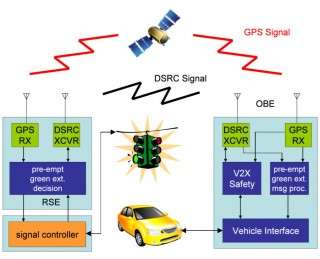October 27, 2010 weblog
Smart traffic lights reduce fuel usage and lower emissions

(PhysOrg.com) -- Denso Corp. has designed the next version of 'the smart traffic light system'. By using messaging between vehicles and the traffic-light controller, better decisions about when to change signaling will help to maximize overall vehicle throughput at an intersection.
Today’s traffic light system collects sensor data from a loop of wire in the roadway to determine when the light should change. The car-sensing light stays green in one direction until a car wants to enter the intersection from the cross street. By reducing the time vehicles idle at a red light helps cut down on their emissions and fuel consumption.

Denso Corp has proposed a system that uses short-range wireless transmitters in cars and elements of the road infrastructure. This would give traffic lights more information about upcoming vehicles and could change dynamically based on their speed, vehicle type, and relative volume of approaching vehicles. This would inform a stoplight of approaching vehicles and delay the change long enough to let them pass.
Denso has taken this proposed system one step further so that an intersection can achieve optimum flow of traffic. They have gone beyond the current signal-control algorithms, that employs averages of traffic flow, in order to adjust cycle times and light extensions to achieve the optimum traffic flow for any given set of approaching vehicles.
Denso Corp has been successfully implementing and testing both pre-empting red lights and extending green lights by using vehicle equipped transmitters and receivers in traffic lights at its Vista, California, research facility.
More information:
-- SAE.org
-- IBM wants traffic lights to stop your car
Via: GreenCarReports
© 2010 PhysOrg.com


















